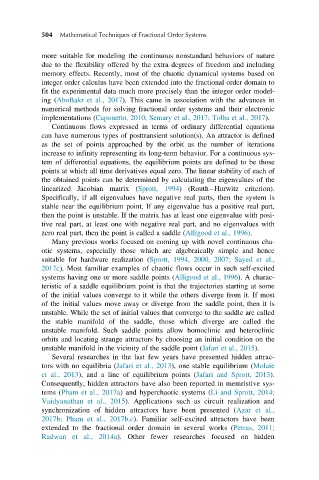Page 517 - Mathematical Techniques of Fractional Order Systems
P. 517
504 Mathematical Techniques of Fractional Order Systems
more suitable for modeling the continuous nonstandard behaviors of nature
due to the flexibility offered by the extra degrees of freedom and including
memory effects. Recently, most of the chaotic dynamical systems based on
integer order calculus have been extended into the fractional order domain to
fit the experimental data much more precisely than the integer order model-
ing (AboBakr et al., 2017). This came in association with the advances in
numerical methods for solving fractional order systems and their electronic
implementations (Caponetto, 2010; Semary et al., 2017; Tolba et al., 2017).
Continuous flows expressed in terms of ordinary differential equations
can have numerous types of posttransient solution(s). An attractor is defined
as the set of points approached by the orbit as the number of iterations
increase to infinity representing its long-term behavior. For a continuous sys-
tem of differential equations, the equilibrium points are defined to be those
points at which all time derivatives equal zero. The linear stability of each of
the obtained points can be determined by calculating the eigenvalues of the
linearized Jacobian matrix (Sprott, 1994) (Routh Hurwitz criterion).
Specifically, if all eigenvalues have negative real parts, then the system is
stable near the equilibrium point. If any eigenvalue has a positive real part,
then the point is unstable. If the matrix has at least one eigenvalue with posi-
tive real part, at least one with negative real part, and no eigenvalues with
zero real part, then the point is called a saddle (Alligood et al., 1996).
Many previous works focused on coming up with novel continuous cha-
otic systems, especially those which are algebraically simple and hence
suitable for hardware realization (Sprott, 1994, 2000, 2007; Sayed et al.,
2017c). Most familiar examples of chaotic flows occur in such self-excited
systems having one or more saddle points (Alligood et al., 1996). A charac-
teristic of a saddle equilibrium point is that the trajectories starting at some
of the initial values converge to it while the others diverge from it. If most
of the initial values move away or diverge from the saddle point, then it is
unstable. While the set of initial values that converge to the saddle are called
the stable manifold of the saddle, those which diverge are called the
unstable manifold. Such saddle points allow homoclinic and heteroclinic
orbits and locating strange attractors by choosing an initial condition on the
unstable manifold in the vicinity of the saddle point (Jafari et al., 2015).
Several researches in the last few years have presented hidden attrac-
tors with no equilibria (Jafari et al., 2013), one stable equilibrium (Molaie
et al., 2013), and a line of equilibrium points (Jafari and Sprott, 2013).
Consequently, hidden attractors have also been reported in memristive sys-
tems (Pham et al., 2017a) and hyperchaotic systems (Li and Sprott, 2014;
Vaidyanathan et al., 2015). Applications such as circuit realization and
synchronization of hidden attractors have been presented (Azar et al.,
2017b; Pham et al., 2017b,c). Familiar self-excited attractors have been
extended to the fractional order domain in several works (Petras, 2011;
Radwan et al., 2014a). Other fewer researches focused on hidden

